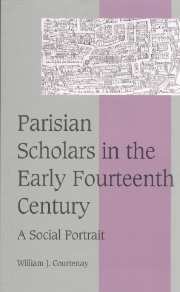Book contents
- Frontmatter
- Contents
- List of maps and figures
- Preface
- List of abbreviations
- INTRODUCTION: PARIS IN 1329
- Part I The recovery and context of a document
- Part II A window on a lost world
- Part III Biographical register
- Select bibliography
- Index of persons and places
- Subject index
- Cambridge Studies in Medieval Life and Thought Fourth series
Preface
Published online by Cambridge University Press: 17 August 2009
- Frontmatter
- Contents
- List of maps and figures
- Preface
- List of abbreviations
- INTRODUCTION: PARIS IN 1329
- Part I The recovery and context of a document
- Part II A window on a lost world
- Part III Biographical register
- Select bibliography
- Index of persons and places
- Subject index
- Cambridge Studies in Medieval Life and Thought Fourth series
Summary
For more than a century, the history of the university of Paris and of medieval universities in general has been reconstructed largely from statutory evidence and from the written products of their schools and convents. This type of documentation initially led historians to focus their attention on questions of origin, constitutional structure, curriculum, and secondarily on intellectual activities and the conjectured daily life of students. Once the early stages of development had taken place, the institutional structure of each university was thought to be set, and descriptions of those structures were presumably as applicable to the late fourteenth century as they were to the early thirteenth. Where changes in degree requirements or administrative authority were noted, these were viewed as slight variations that did not significantly alter the continuity of basic structures. Change lay in the growth of colleges, the introduction and accommodation of the mendicant orders into universities, and the different intellectual currents and schools of thought that arose, waned, or reappeared as one moved from the thirteenth to the fifteenth century.
In recent years the interests of historians have shifted more to questions of social background, geographical recruitment, careers of students and masters, and the interaction of universities with the surrounding society. This shift is evident in the work of A. B. Cobban, Guy Lytle, Jürgen Miethke, Peter Moraw, Hilde de Ridder-Symoens, Rainer Schwinges, Jacques Verger, and numerous others.
- Type
- Chapter
- Information
- Parisian Scholars in the Early Fourteenth CenturyA Social Portrait, pp. xi - xvPublisher: Cambridge University PressPrint publication year: 1999

